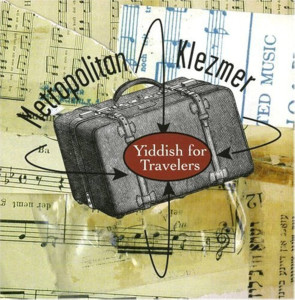 Judith Gennett wrote this review.
Judith Gennett wrote this review.
Some people — me for example — think of klezmer as great party music, even though they’ve never been to a Jewish party! I always think of partying when I hear klezmer, even if I am deep in the Cascadian forest and the other partygoers are pine trees!
Metropolitan Klezmer is from New York City, far from these Pacific mountains. Formed in 1994, they released their first album Yiddish For Travelers in 1997, and their second Mosaic Persuasion in 2001. The women who are part of Metropolitan Klezmer do double time in an all-girl band called Isle Of Klezbos, which has other members as well. Both groups have similar instruments and arrangements and include some non-Jewish musicians. Most have played several other styles of music, ranging from Cajun to Greek to jazz. As in many bands, these influences have led to a cosmopolitan sound, integrated at the roots, so that the music sounds like vivid, solid klezmer instead of fusion. And they don’t sound cheesy either — something people out here worry about!
What an ethnic party headbanger! There is not a track on Yiddish For Travelers that drags; the slower tracks move a long like a diesel ferry through the dark waters of night. MK, with its often perky brass and drums and more subtle clarinet, violin, and accordion, visits a number of locales. Most are similarly rich, eastern, and captured with energy and soul, but a few break the mold. “Mangiko/Yoske Fort Avek” sounds Greek to me, because the first part is the Greek original played by Michael Hess on kanun (Middle Eastern) zither; the second part is the Yiddish derivative. Speaking of trips to other places, “Russian Sher” and a string of Romanian  tracks seem not really so unlike each other in style, and point toward a homeland based on culture and religion rather than geography. But those geographic differences do exist in the tunes.
tracks seem not really so unlike each other in style, and point toward a homeland based on culture and religion rather than geography. But those geographic differences do exist in the tunes.
Yiddish For Travelers also includes a few show and movie tunes, not uncommon for klezmerites. Deborah Karpel sings two of these, in a sweet but piercing low soprano. “Fralangen/Longing” is from a 1937 Polish movie. “A young woman sits in an alcove with her face against the wall.” The jazzy “Sheyn Vi Di Levone/Beautiful As the Moon” is from the Yiddish theatre.
The 17 track Pre-Release Teaser of the joint MK/Klezbos CD is, as I write this, being sold at gigs and to klezheads who inquire. It shows MK as continuing on their sturdy, raucous road, while Isle Of Klezbos follows a slightly smoother track. Three of the six energetic MK tracks are live, but the recording is so good, and the production so true, that it is hard to tell. The only full-length “produced” item from the original band is a perky “Tailor’s Bounce,” which carries a sense of many threads intertwining.
Though IOK also bounces around a lot, for example in the slapstick “Golden Wedding,” many of their tracks seem like slow moving clouds of steam, in this case the two bracketing tunes, “Houdini Hora” and sax/clarinetist Debra Kreisberg’s ethnojazz composition “Abrah,” as well as a much later track, “Revery In Hijaz.” Hijaz with trumpet high jazz as well! Another, “Father’s Cadenzas,” seems always ready to take off, but never does … until it segues into the next track, the short but peppery “My Father’s Nigun.” The leader of both bands is drummer Eve Sicular, so percussion has clout in all the arrangements, but you might also hear Catherine Popper’s bass as rhythm. As for the faster tunes, the unusual one is “Klezmerenge”; IOK throws in a fast merenge accordion run the way some other bands throw in klezmer!
Nice solid bands, nice glitch-resistant albums. These are recommended for danceaholics and partygoers from anywhere … but especially those who like those Eastern sounds!
(Metropolitan Klezmer, 1997)
(Metropolitan Klezmer, 2002)
